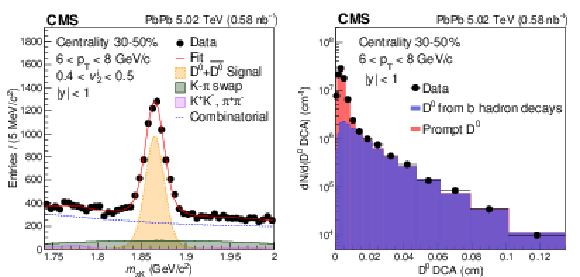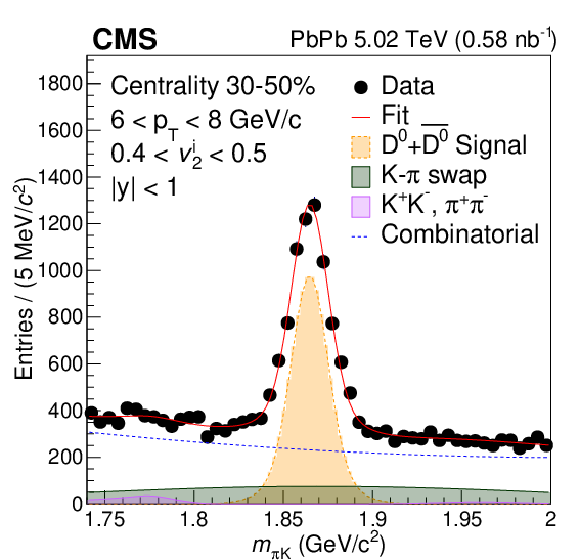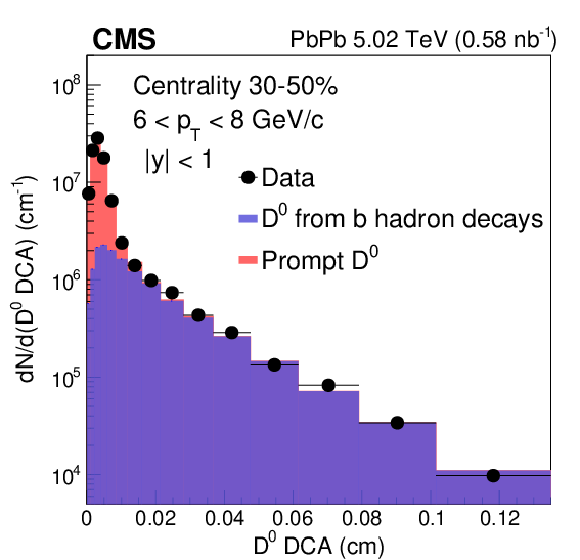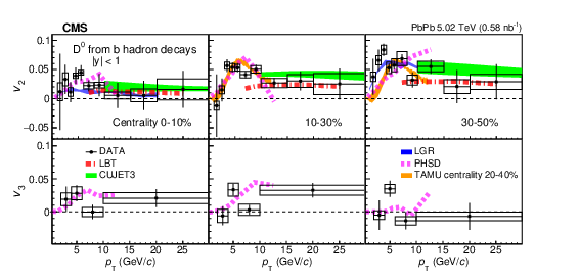

Compact Muon Solenoid
LHC, CERN
| CMS-HIN-21-003 ; CERN-EP-2022-219 | ||
| Measurements of azimuthal anisotropy of nonprompt D$^{0} $ mesons in PbPb collisions at $ \sqrt{\smash[b]{s_{_{\mathrm{NN}}}}}= $ 5.02 TeV | ||
| CMS Collaboration | ||
| 3 December 2022 | ||
| Phys. Lett. B 850 (2024) 138389 | ||
| Abstract: Measurements of the elliptic ($ v_{2} $) and triangular ($ v_{3} $) azimuthal anisotropy coefficients are presented for D$^{0} $ mesons produced in b hadron decays (nonprompt D$^{0} $ mesons) in lead-lead collisions at $ \sqrt{\smash[b]{s_{_{\mathrm{NN}}}}}= $ 5.02 TeV. The results are compared with previously published charm meson anisotropies measured using prompt D$^{0} $ mesons. The data were collected with the CMS detector in 2018 with an integrated luminosity of 0.58 nb$^{-1}$. Azimuthal anisotropy is sensitive to the interactions of quarks with the hot and dense medium created in heavy ion collisions. Comparing results for prompt and nonprompt D$^{0} $ mesons can assist in understanding the mass dependence of these interactions. The nonprompt results show lower magnitudes of $ v_{2} $ and $ v_{3} $ and weaker dependences on the meson transverse momentum and collision centrality than those found for prompt D$^{0} $ mesons. By comparing to theoretical predictions, the results imply that there is a mass hierarchy of quark interactions with the medium. | ||
| Links: e-print arXiv:2212.01636 [hep-ex] (PDF) ; CDS record ; inSPIRE record ; HepData record ; CADI line (restricted) ; | ||
| Figures | |

png pdf |
Figure 1:
An example of the fit to the invariant mass spectrum (left panel) and an example of the template fit of the inclusive D$^{0} $ meson yields, extracted as a function of DCA (right panel). The former fit is used for determining the total D$^{0} $ yields and the latter for determining the fraction of nonprompt D$^{0} $ mesons. |

png pdf |
Figure 1-a:
An example of the fit to the invariant mass spectrum (left panel) and an example of the template fit of the inclusive D$^{0} $ meson yields, extracted as a function of DCA (right panel). The former fit is used for determining the total D$^{0} $ yields and the latter for determining the fraction of nonprompt D$^{0} $ mesons. |

png pdf |
Figure 1-b:
An example of the fit to the invariant mass spectrum (left panel) and an example of the template fit of the inclusive D$^{0} $ meson yields, extracted as a function of DCA (right panel). The former fit is used for determining the total D$^{0} $ yields and the latter for determining the fraction of nonprompt D$^{0} $ mesons. |

png pdf |
Figure 2:
The elliptic, $ v_{2} $ (upper panels), and the triangular, $ v_{3} $ (lower panels), flow coefficients of nonprompt and prompt (from Ref. [18]) D$^{0} $ mesons as functions of their $ p_{\mathrm{T}} $ and in three bins of centrality. The bars and the boxes represent statistical and systematic uncertainties, respectively. |

png pdf |
Figure 3:
The elliptic, $ v_{2} $ (upper panel), and the triangular, $ v_{3} $ (lower panel), flow coefficients of nonprompt D$^{0} $ mesons as functions of their $ p_{\mathrm{T}} $ and in three bins of centrality. The bars and the boxes represent statistical and systematic uncertainties, respectively. The colored bands show theoretical predictions [49-56]. |
| Summary |
| In summary, the elliptic ($ v_{2} $) and triangular ($ v_{3} $) flow harmonics of D$^{0} $ mesons that originate in b hadron decays (nonprompt D$^{0} $ mesons) are measured in lead-lead collisions at $ \sqrt{\smash[b]{s_{_{\mathrm{NN}}}}}= $ 5.02 TeV. The $ v_{2} $ results show a weak transverse momentum ($ p_{\mathrm{T}} $) dependence and suggest a slight increase for more peripheral collisions. An indication of a nonzero $ v_{3} $ coefficient is found for nonprompt D$^{0} $ mesons with 4 $ < p_{\mathrm{T}} < $ 6 GeV/$c$. The magnitudes of the flow coefficients are lower for nonprompt D$^{0} $ than for prompt D$^{0} $ mesons. This magnitude difference is more pronounced in the case of $ v_{2} $. Comparisons of the results to theoretical models suggest a mass hierarchy in quark interactions with the quark-gluon plasma, thereby extending our understanding of heavy quark interactions with the medium. |
| References | ||||
| 1 | BRAHMS Collaboration | Quark-gluon plasma and color glass condensate at RHIC? The perspective from the BRAHMS experiment | Nucl. Phys. A 757 (2005) 1 | nucl-ex/0410020 |
| 2 | PHOBOS Collaboration | The PHOBOS perspective on discoveries at RHIC | Nucl. Phys. A 757 (2005) 28 | nucl-ex/0410022 |
| 3 | STAR Collaboration | Experimental and theoretical challenges in the search for the quark-gluon plasma: the STAR Collaboration's critical assessment of the evidence from RHIC collisions | Nucl. Phys. A 757 (2005) 102 | nucl-ex/0501009 |
| 4 | PHENIX Collaboration | Formation of dense partonic matter in relativistic nucleus-nucleus collisions at RHIC: experimental evaluation by the PHENIX Collaboration | Nucl. Phys. A 757 (2005) 184 | nucl-ex/0410003 |
| 5 | S. A. Voloshin and Y. Zhang | Flow study in relativistic nuclear collisions by Fourier expansion of azimuthal particle distributions | Z. Phys. C 70 (1996) 665 | hep-ph/9407282 |
| 6 | W. Busza, K. Rajagopal, and W. van der Schee | Heavy ion collisions: the big picture, and the big questions | Ann. Rev. Nucl. Part. Sci. 68 (2018) 339 | 1802.04801 |
| 7 | J.-Y. Ollitrault | Anisotropy as a signature of transverse collective flow | PRD 46 (1992) 229 | |
| 8 | U. Heinz and R. Snellings | Collective flow and viscosity in relativistic heavy-ion collisions | Ann. Rev. Nucl. Part. Sci. 63 (2013) 123 | 1301.2826 |
| 9 | C. Gale, S. Jeon, and B. Schenke | Hydrodynamic modeling of heavy-ion collisions | Int. J. Mod. Phys. A 28 (2013) 1340011 | 1301.5893 |
| 10 | B. Alver and G. Roland | Collision-geometry fluctuations and triangular flow in heavy-ion collisions | Phys. Rev. C 81 (2010) 054905 | 1003.0194 |
| 11 | F. Prino and R. Rapp | Open heavy flavor in QCD matter and in nuclear collisions | JPG 43 (2016) 093002 | 1603.00529 |
| 12 | R. Rapp et al. | Extraction of heavy-flavor transport coefficients in QCD matter | Nucl. Phys. A 979 (2018) 21 | 1803.03824 |
| 13 | H. van Hees, V. Greco, and R. Rapp | Heavy-quark probes of the quark-gluon plasma and interpretation of recent data taken at the BNL Relativistic Heavy Ion Collider | Phys. Rev. C 73 (2006) 034913 | nucl-th/0508055 |
| 14 | M. Gyulassy, I. Vitev, and X.-N. Wang | High $ p_{\mathrm{T}} $ azimuthal asymmetry in noncentral A+A at RHIC | PRL 86 (2001) 2537 | nucl-th/0012092 |
| 15 | E. V. Shuryak | Azimuthal asymmetry at large $ p_{\mathrm{T}} $ seem to be too large for a pure ``jet quenching'' | Phys. Rev. C 66 (2002) 027902 | nucl-th/0112042 |
| 16 | ALICE Collaboration | D-meson azimuthal anisotropy in midcentral Pb-Pb collisions at $ \sqrt{\smash[b]{s_{_{\mathrm{NN}}}}} = $ 5.02 TeV | PRL 120 (2018) 102301 | 1707.01005 |
| 17 | CMS Collaboration | Measurement of prompt $ \mathrm{D^0} $ meson azimuthal anisotropy in Pb-Pb collisions at $ \sqrt{\smash[b]{s_{_{\mathrm{NN}}}}}= $ 5.02 TeV | PRL 120 (2018) 202301 | CMS-HIN-16-007 1708.03497 |
| 18 | CMS Collaboration | Measurement of prompt $ \mathrm{D}^0 $ and $ \overline{\mathrm{D}}^0 $ meson azimuthal anisotropy and search for strong electric fields in PbPb collisions at $ \sqrt{\smash[b]{s_{_{\mathrm{NN}}}}}= $ 5.02 TeV | PLB 816 (2021) 136253 | CMS-HIN-19-008 2009.12628 |
| 19 | ATLAS Collaboration | Measurement of azimuthal anisotropy of muons from charm and bottom hadrons in Pb+Pb collisions at $ \sqrt{\smash[b]{s_{_{\mathrm{NN}}}}} = $ 5.02 TeV with the ATLAS detector | PLB 807 (2020) 135595 | 2003.03565 |
| 20 | ALICE Collaboration | $ \mathrm{J}/\psi $ elliptic and triangular flow in Pb-Pb collisions at $ \sqrt{\smash[b]{s_{_{\mathrm{NN}}}}} = $ 5.02 TeV | JHEP 10 (2020) 141 | 2005.14518 |
| 21 | CMS Collaboration | Probing charm quark dynamics via multiparticle correlations in PbPb collisions at $ \sqrt{\smash[b]{s_{_{\mathrm{NN}}}}} = $ 5.02 TeV | PRL 129 (2022) 022001 | CMS-HIN-20-001 2112.12236 |
| 22 | CMS Collaboration | Suppression and azimuthal anisotropy of prompt and nonprompt $ \mathrm{J}/\psi $ production in PbPb collisions at $ \sqrt{\smash[b]{s_{_{\mathrm{NN}}}}} = $ 2.76 TeV | EPJC 77 (2017) 252 | CMS-HIN-14-005 1610.00613 |
| 23 | ALICE Collaboration | Elliptic flow of electrons from beauty-hadron decays in Pb-Pb collisions at $ \sqrt{\smash[b]{s_{_{\mathrm{NN}}}}} = $ 5.02 TeV | PRL 126 (2021) 162001 | 2005.11130 |
| 24 | CMSnoop | HEPData record for this analysis | link | |
| 25 | CMS Collaboration | The CMS experiment at the CERN LHC | JINST 03 (2008) S08004 | |
| 26 | CMS Collaboration | Performance of the CMS level-1 trigger in proton-proton collisions at $ \sqrt{s} = $ 13 TeV | JINST 15 (2020) P10017 | CMS-TRG-17-001 2006.10165 |
| 27 | CMS Collaboration | The CMS trigger system | JINST 12 (2017) P01020 | CMS-TRG-12-001 1609.02366 |
| 28 | CMS Collaboration | Electron and photon reconstruction and identification with the CMS experiment at the CERN LHC | JINST 16 (2021) P05014 | CMS-EGM-17-001 2012.06888 |
| 29 | CMS Collaboration | Performance of the CMS muon detector and muon reconstruction with proton-proton collisions at $ \sqrt{s}= $ 13 TeV | JINST 13 (2018) P06015 | CMS-MUO-16-001 1804.04528 |
| 30 | CMS Collaboration | Description and performance of track and primary-vertex reconstruction with the CMS tracker | JINST 9 (2014) P10009 | CMS-TRK-11-001 1405.6569 |
| 31 | CMS Collaboration | Particle-flow reconstruction and global event description with the CMS detector | JINST 12 (2017) P10003 | CMS-PRF-14-001 1706.04965 |
| 32 | CMS Collaboration | Observation and studies of jet quenching in PbPb collisions at $ \sqrt{\smash[b]{s_{_{\mathrm{NN}}}}}= $ 2.76 TeV | Phys. Rev. C 84 (2011) 024906 | CMS-HIN-10-004 1102.1957 |
| 33 | CMS Collaboration | Precision luminosity measurement in proton-proton collisions at $ \sqrt{s}= $ 13 TeV in 2015 and 2016 at CMS | EPJC 81 (2021) 800 | CMS-LUM-17-003 2104.01927 |
| 34 | CMS Collaboration | CMS luminosity measurement using nucleus-nucleus collisions at $ \sqrt{\smash[b]{s_{_{\mathrm{NN}}}}}= $ 5.02 TeV in 2018 | CMS Physics Analysis Summary, 2022 CMS-PAS-LUM-18-001 |
CMS-PAS-LUM-18-001 |
| 35 | CMS Collaboration | Charged-particle nuclear modification factors in PbPb and pPb collisions at $ \sqrt{\smash[b]{s_{_{\mathrm{NN}}}}}= $ 5.02 TeV | JHEP 04 (2017) 039 | CMS-HIN-15-015 1611.01664 |
| 36 | T. Sjöstrand et al. | An introduction to PYTHIA 8.2 | Comput. Phys. Commun. 191 (2015) 159 | 1410.3012 |
| 37 | CMS Collaboration | Extraction and validation of a new set of CMS PYTHIA8 tunes from underlying-event measurements | EPJC 80 (2020) 4 | CMS-GEN-17-001 1903.12179 |
| 38 | D. J. Lange | The EVTGEN particle decay simulation package | NIM A 462 (2001) 152 | |
| 39 | I. P. Lokhtin and A. M. Snigirev | A model of jet quenching in ultrarelativistic heavy ion collisions and high-$ p_{\mathrm{T}} $ hadron spectra at RHIC | EPJC 45 (2006) 211 | hep-ph/0506189 |
| 40 | GEANT4 Collaboration | GEANT 4---a simulation toolkit | NIM A 506 (2003) 250 | |
| 41 | Particle Data Group Collaboration | Review of particle physics | Prog. Theor. Exp. Phys. 2022 (2022) 083C01 | |
| 42 | H. Voss, A. Höcker, J. Stelzer, and F. Tegenfeldt | TMVA, the toolkit for multivariate data analysis with ROOT | in XIth International Workshop on Advanced Computing and Analysis Techniques in Physics Research (ACAT), . . . [PoS(ACAT)040], 2007 link |
physics/0703039 |
| 43 | STAR Collaboration | Elliptic flow from two- and four-particle correlations in Au + Au collisions at $ \sqrt{\smash[b]{s_{_{\mathrm{NN}}}}} = $ 130 GeV | Phys. Rev. C 66 (2002) 034904 | nucl-ex/0206001 |
| 44 | A. M. Poskanzer and S. A. Voloshin | Methods for analyzing anisotropic flow in relativistic nuclear collisions | Phys. Rev. C 58 (1998) 1671 | nucl-ex/9805001 |
| 45 | NA49 Collaboration | Directed and elliptic flow of charged pions and protons in Pb+Pb collisions at 40A and 158A GeV | Phys. Rev. C 68 (2003) 034903 | nucl-ex/0303001 |
| 46 | M. J. Oreglia | A study of the reactions $ \psi^\prime \to \gamma \gamma \psi $ | PhD thesis, Stanford University, . SLAC Report SLAC-R-236, 1980 link |
|
| 47 | CMS Collaboration | Studies of charm and beauty hadron long-range correlations in pp and pPb collisions at LHC energies | PLB 813 (2021) 136036 | CMS-HIN-19-009 2009.07065 |
| 48 | CMS Collaboration | Studies of beauty suppression via nonprompt $ \mathrm{D}^0 $ mesons in Pb-Pb collisions at $ \sqrt{\smash[b]{s_{_{\mathrm{NN}}}}} = $ 5.02 TeV | PRL 123 (2019) 022001 | CMS-HIN-16-016 1810.11102 |
| 49 | T. Song et al. | Tomography of the quark-gluon plasma by charm quarks | Phys. Rev. C 92 (2015) 014910 | 1503.03039 |
| 50 | S. Cao, T. Luo, G.-Y. Qin, and X.-N. Wang | Linearized Boltzmann transport model for jet propagation in the quark-gluon plasma: heavy quark evolution | Phys. Rev. C 94 (2016) 014909 | 1605.06447 |
| 51 | W.-J. Xing, S. Cao, G.-Y. Qin, and H. Xing | Flavor hierarchy of jet quenching in relativistic heavy-ion collisions | PLB 805 (2020) 135424 | 1906.00413 |
| 52 | M. He, R. J. Fries, and R. Rapp | Heavy flavor at the large hadron collider in a strong coupling approach | PLB 735 (2014) 445 | 1401.3817 |
| 53 | S. Li, C. Wang, W. Renzhuo, and J. Liao | Probing the transport properties of quark-gluon plasma via heavy-flavor Boltzmann and Langevin dynamics | Phys. Rev. C 99 (2019) 054909 | 1901.04600 |
| 54 | S. Li and J. Liao | Data-driven extraction of heavy quark diffusion in quark-gluon plasma | EPJC 80 (2020) 7 | 1912.08965 |
| 55 | S. Shi, J. Liao, and M. Gyulassy | Probing the color structure of the perfect QCD fluids via soft-hard-event-by-event azimuthal correlations | Chin. Phys. C 42 (2018) 104104 | 1804.01915 |
| 56 | S. Shi, J. Liao, and M. Gyulassy | Global constraints from RHIC and LHC on transport properties of QCD fluids in CUJET/CIBJET framework | Chin. Phys. C 43 (2019) 044101 | 1808.05461 |

|
Compact Muon Solenoid LHC, CERN |

|

|

|

|

|

|